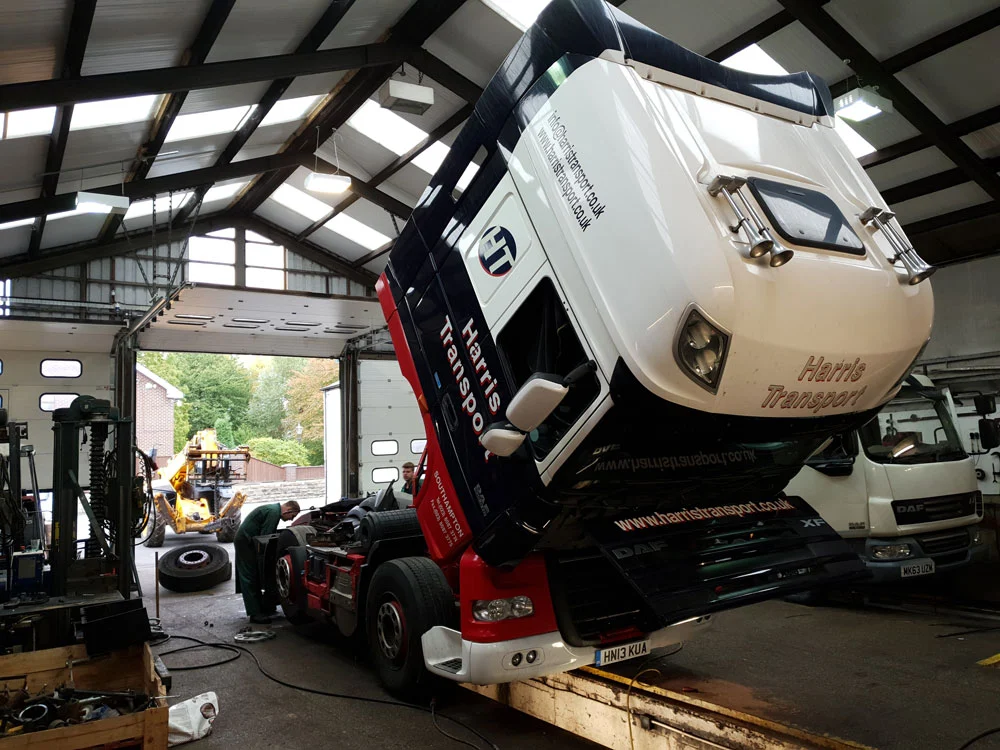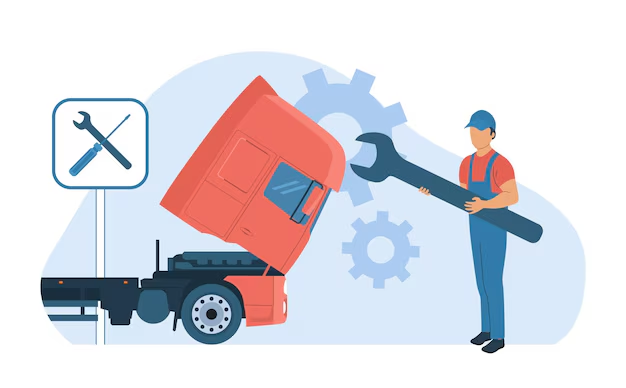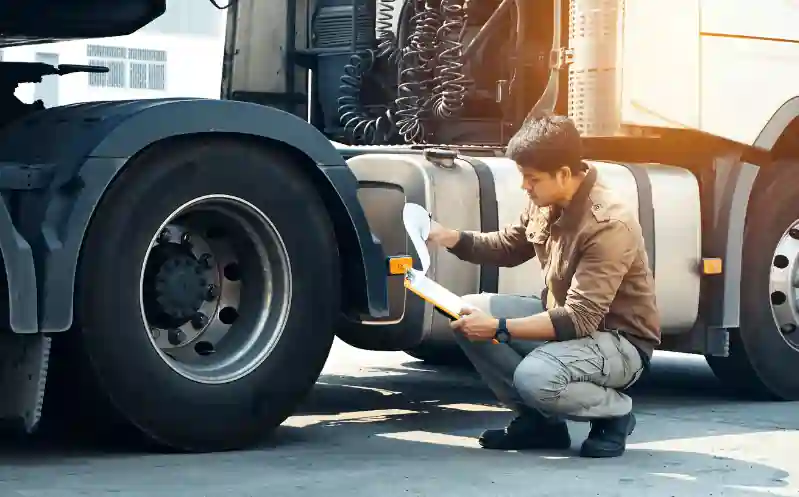When it comes to driving a truck, whether for a company or as an owner-operator, safety is the top priority. One of the most important aspects of truck safety is the DOT Inspection.
This is an inspection conducted by the Department of Transportation (DOT) to ensure that commercial vehicles meet specific safety standards.
These inspections are not just a requirement; they help keep our roads safe by making sure that trucks are in good working condition, reducing the risk of accidents.
The DOT Inspection process is more than just a check-up; it plays a significant role in determining how well a truck is maintained.
For truckers and trucking companies, the results of a DOT Inspection can greatly affect their business operations.
A truck’s Safety Rating reflects how compliant the trucker is with safety standards. It is determined by the results of these inspections.
Safety ratings are very important. A high Safety Rating shows that a trucking company or driver is meeting safety requirements and can build trust with customers.
A low Safety Rating can lead to lost contracts, higher insurance costs, and even suspension of operations in some cases.
Understanding the relationship between DOT Inspections and Safety Ratings is essential for maintaining a successful trucking business.
A DOT Inspection is a thorough check-up required for commercial vehicles, such as trucks, to ensure they meet the safety standards set by the Department of Transportation (DOT).
The purpose of this inspection is to make sure that trucks are in good condition, safe to drive, and compliant with regulations that help prevent accidents.
The DOT Safety Standards are rules that trucks must follow to operate legally on the roads.
These standards cover various parts of the vehicle, including brakes, tires, lights, and engine systems. By ensuring that trucks meet these safety standards, DOT Inspections help reduce the risks of accidents caused by vehicle malfunctions, making the roads safer for everyone.
There are different levels of DOT Inspections, each focusing on specific aspects of the truck and driver. Here are the main types:
All of these inspections are guided by FMCSA (Federal Motor Carrier Safety Administration) and CVSA (Commercial Vehicle Safety Alliance) regulations, which set the standards for vehicle safety and driver compliance across North America.
DOT Inspections can be performed at various locations. Some of the most common places include:
It’s important to schedule your DOT Inspection at trusted locations where certified DOT Officers or professionals are conducting the checks.
This ensures the inspection meets all required standards and helps maintain your truck’s compliance with DOT regulations.

Safety Ratings are evaluations given to trucking companies and individual truckers based on their compliance with DOT safety standards.
These ratings reflect how well a company or trucker maintains their vehicles and follows regulations that ensure road safety. There are three types of safety ratings:
These safety ratings play a crucial role in a trucking company’s success. A Satisfactory rating can open doors to more business opportunities, while a Conditional or Unsatisfactory rating can lead to challenges in securing loads and even affect insurance rates.
If you have received a Conditional Safety Rating after a DOT Inspection, it’s essential to take steps to improve it. Here are some tips:
Receiving an Unsatisfactory rating can have serious consequences for a trucking company or owner-operator.
If your safety rating is Unsatisfactory, you must take immediate action. This includes improving your compliance and addressing any major safety issues.
You are required to make the necessary improvements within 45-60 days or face legal repercussions, including:
To avoid this, it’s critical to act quickly to resolve any issues pointed out during your DOT Inspection.
Regular maintenance, up-to-date driver training, and proactive safety practices are key to improving your rating. These steps help keep your operations running smoothly.

A Truck Inspection Checklist is an essential tool that helps truckers and trucking companies ensure that their vehicles are compliant with DOT safety standards before they hit the road.
It covers a range of areas, ensuring that everything from the tires to the brake systems are checked. This ensures that all components are in good working order. Here’s a breakdown of the key components that should be checked:
Regular vehicle maintenance is crucial for passing DOT inspections. It also helps keep the truck in good working condition and ensures the safety of the driver and others.
By conducting regular inspections and addressing potential issues, truckers can minimize the risk of failing a DOT Inspection. Here’s how proper maintenance helps:
Regularly scheduled preventive maintenance checks, such as oil changes, brake adjustments, and tire rotations, help keep the vehicle running smoothly. They can also identify small issues before they become big problems. This proactive approach reduces the risk of major breakdowns and ensures compliance with DOT safety standards.
In addition to pre-trip inspections, it is essential to have regular safety inspections. These inspections can be conducted at trucking maintenance facilities. Professionals ensure that the vehicle is in top shape and meets DOT inspection requirements.
Trucking maintenance facilities play a significant role in helping truckers maintain their vehicles and stay compliant with DOT regulations. These facilities are equipped to carry out detailed inspections and necessary repairs, making sure the truck is in safe operating condition before the next journey.
Tools like TruckingOffice PRO can help truckers stay organized and track their maintenance schedules and DOT inspections. These software systems make it easier to manage routine maintenance, track repairs, and monitor the truck’s compliance with safety standards. They can also help track driver documentation, making sure that all paperwork is up-to-date and ready for inspections.
By maintaining the truck in top condition and keeping accurate records, trucking companies and owner-operators can reduce the likelihood of receiving a Conditional rating.
This helps avoid an Unsatisfactory Safety Rating after a DOT Inspection.
For a more comprehensive safety kit, including tire traction aids, the TruckClaws™ Commercial Truck Kit is an essential addition to your vehicle’s emergency toolkit.
Regular maintenance ensures not only compliance with DOT safety standards but also the safety of everyone on the road.

In today’s trucking industry, staying compliant with DOT safety standards and managing inspections efficiently is vital.
Trucking software for safety, such as TruckingOffice PRO, is a powerful tool that helps owner-operators and trucking companies streamline their processes and stay on top of their maintenance and inspection schedules. Here’s how TruckingOffice PRO can help:
The benefit of using trucking software for safety is that it helps truckers and trucking businesses stay organized, comply with regulations, and ultimately improve their safety ratings.
This leads to better business opportunities, as companies with high safety ratings are more likely to receive contracts and discounts from shippers.
The FMCSA SAFER System is a valuable resource for both truckers and trucking companies.
Managed by the Federal Motor Carrier Safety Administration (FMCSA), the SAFER System tracks important safety data, including DOT inspection records, safety ratings, and out-of-service violations.
Here’s how it works and how you can use it to manage inspections and improve compliance:
The FMCSA SAFER System provides access to DOT inspection records for all registered trucking companies.
This system tracks both pass and fail inspection results, helping truckers understand where they need to make improvements.
By reviewing these reports, truckers can prepare for future inspections and take action to prevent issues before they arise.
Truckers and companies can use the SAFER System to check their safety ratings (Satisfactory, Conditional, and Unsatisfactory).
This system provides up-to-date information on the company’s safety standing, including details of any recent inspections or violations.
Having access to this data allows companies to see if they need to make changes to improve their rating.
The SAFER System can help truckers and trucking businesses improve their compliance by tracking and managing safety records.
If a trucker receives a Conditional or Unsatisfactory Rating, they can use the system to identify the issues and take steps to address them, such as scheduling additional inspections or addressing maintenance issues.
In addition to inspection data, the SAFER System provides detailed records of company audits and violations, helping companies ensure that they are fully compliant with FMCSA regulations.
It can also be a valuable tool for owner-operators when applying for business opportunities or contracts, as a clean safety record can improve their chances of success.
By leveraging the FMCSA SAFER System, truckers can ensure that they are in compliance with all relevant safety standards and maintain a good safety rating.
This can open up new business opportunities and lead to better safety on the road.
In conclusion, using tools like TruckingOffice PRO for managing inspections and maintenance, along with leveraging the FMCSA SAFER System to track and improve safety ratings, helps truckers and trucking businesses stay compliant with DOT regulations.
Together, these resources play a crucial role in maintaining safety standards, passing inspections, and boosting overall business performance.
Having a poor safety rating can significantly affect a trucking company’s operations and reputation.
Safety ratings are crucial for businesses in the trucking industry, and DOT inspections play a key role in determining them. Here’s how a low safety rating can cause problems for truckers:
TTo avoid the negative consequences of a poor safety rating, trucking companies should maintain their vehicles and train their drivers. They should also use available tools for compliance to ensure smooth DOT inspections.
Here are some preventive measures that can help avoid Unsatisfactory ratings:
One of the most important steps in passing DOT inspections is keeping the truck in good condition.
Regular vehicle maintenance is crucial for ensuring that all the essential components, such as brakes, tires, lights, and engine systems, are functioning properly.
Regular checks can help identify potential problems early and address them before inspections. This includes checking the brake system, tire pressure, and engine fluid levels as part of a pre-trip inspection.
Drivers should be trained on DOT inspection requirements and what inspectors will be looking for during roadside or annual inspections.
Educating drivers about the importance of maintaining a clean and organized truck can prevent mistakes and omissions that lead to failures during inspections.
Proper training ensures that drivers are familiar with safety regulations, such as keeping logbooks and medical cards up to date. It also helps them follow other compliance procedures.
Leveraging truck inspection software like TruckingOffice PRO can help streamline the process of keeping records of inspections, repairs, and maintenance schedules.
The software can send reminders for scheduled inspections and maintenance, ensuring that nothing is overlooked.
It also allows truckers to keep digital records of inspection logs and safety data, which can be accessed quickly during an actual DOT inspection, reducing the chances of a failed inspection.
By incorporating these preventive measures into daily operations, truckers and trucking companies can reduce the risk of receiving Conditional or Unsatisfactory safety ratings.
This helps avoid the consequences of poor ratings, such as loss of business opportunities, higher costs, and potential legal issues.
Keeping vehicles in top condition and training drivers effectively will lead to smoother inspections. Using tools like TruckingOffice PRO for managing inspections and maintenance will also improve safety ratings over time.

While standard DOT inspections are essential for maintaining safety and compliance on the road, there are specific circumstances where trucks may undergo Special Inspections.
These inspections are tailored to certain cargo types or unique situations, ensuring that both the vehicle and its cargo meet the necessary safety standards.
Here’s a look at some of the specialized inspection types:
Trucks carrying hazardous materials—such as chemicals, flammable substances, or explosives—require extra scrutiny during inspections.
These trucks are subject to stricter safety checks to ensure the materials are being transported safely and securely.
Special inspection protocols are in place to ensure that the vehicle has the necessary safety equipment, signage, and training to transport hazardous materials safely.
This can include checking for proper spill containment measures, hazardous materials placards, and compliance with DOT safety regulations for dangerous goods.
Trucks that carry radioactive materials are subject to the Enhanced NAS Inspection.
This specialized inspection is designed to ensure that radioactive materials are safely stored, transported, and that the vehicle complies with all specific regulations related to nuclear materials.
This type of inspection is more thorough and focuses on areas like radiation monitoring, cargo security, and the proper containment of the radioactive substances.
It is a critical aspect of ensuring the safety of both the driver and the public.
The NAS Electronic Inspection is a newer method in DOT inspections, allowing for wireless inspections while the vehicle is in motion.
Instead of requiring the vehicle to stop for a traditional roadside inspection, this system uses electronic devices.
These devices inspect the truck’s safety features, such as its brake system, lights, and weight distribution.
This method can streamline inspections, improve efficiency, and allow inspectors to gather safety data without pulling the truck over.
While still in development in some areas, electronic inspections are becoming more common and are part of the evolving DOT inspection process.
Ensuring that DOT inspections are successful requires the active participation of various authorities, as well as proper driver safety training.
Here’s a breakdown of the key players and factors involved in maintaining compliance and safety during inspections:
Ensuring that both the vehicle and driver are prepared for these special inspections is crucial. Maintaining a high level of compliance with DOT regulations keeps operations running smoothly.
By understanding unique inspection types, such as those for hazardous materials and radioactive shipments, truckers can improve safety.
Leveraging modern technologies like the NAS Electronic Inspection can further enhance compliance practices.
Additionally, working closely with Certified DOT Officers and investing in driver training ensures that truckers are always ready for any inspection scenario that might arise.
In summary, DOT Inspections play a critical role in ensuring that commercial vehicles meet the necessary safety standards and operate efficiently on the roads.
By adhering to DOT safety regulations and maintaining a Satisfactory safety rating, trucking companies and truckers can avoid fines, legal issues, and missed opportunities.
It’s crucial to keep vehicles in optimal condition with regular vehicle maintenance and thorough truck inspections to pass these inspections smoothly.
The relationship between DOT inspections, Safety Ratings, and proper vehicle maintenance cannot be overstated.
A high safety rating can make a significant difference in a trucker’s ability to secure loads and get discounts from shippers.
Trucking software tools, like TruckingOffice PRO, can assist in managing inspection logs, maintenance schedules, and improving safety ratings by keeping track of required inspections and repairs.
Additionally, staying updated with the FMCSA SAFER System helps monitor inspection records and safety performance over time.
For truckers and trucking companies, it’s essential to stay proactive when it comes to DOT Inspections and maintaining a strong Safety Rating.
Regular inspections and keeping your vehicle in top shape will help avoid Unsatisfactory ratings and improve operational efficiency.
We encourage you to utilize tools like TruckingOffice PRO or similar trucking software to streamline your inspection and maintenance processes.
These tools help you stay compliant and track inspections. They ensure your vehicles remain roadworthy, saving you time, money, and potential business setbacks.
Always prioritize safety to ensure your business continues running smoothly and efficiently on the road.
